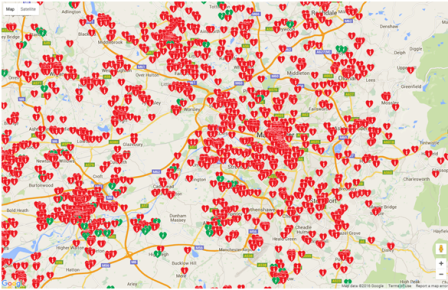Emergency First Aid: How to Locate your Nearest Defibrillator
Date: Wednesday, 13 January 2016. -
Blog, Defibrillators, Training
In our previous blog post, we highlighted the issues surrounding emergency response times and the impact that they can have in life-threatening situations. We also promoted the benefits of learning first aid so that individuals can step in and do everything in their power to help save casualties in a critical condition.
However, in some instances, individuals will not have access to the advanced medical equipment needed to provide effective treatment for the patient. Sudden cardiac arrest is a prime example of one of these instances.
When someone experiences a cardiac arrest early defibrillation is key to their survival. The patient must receive shock therapy as soon as possible because for every minute lost they will lose 7-10% of their survival chances.
The casualty must also receive CPR immediately after collapse to keep their heart in a shockable rhythm so that the defibrillator can perform its role effectively. CPR is a tiring procedure and many people experience fatigue whilst waiting for paramedics to take over.
The best piece of advice we can offer if you ever find yourself in this situation is to shout for help because you’re going to need manpower but most importantly, it will enable you to appoint bystanders with the crucial role of finding the nearest defibrillator.
Public access defibrillators have the same capability as advanced defibrillators found in hospitals but are designed with user-friendliness in mind to support untrained individuals with the defibrillation process. They can be found in supermarkets, train stations, community centres and more, you will be surprised how many you walk past on a regular basis without really registering.

Maybe the locations of these defibrillators will spring up from your subconscious in an emergency situation, but it’s unlikely. Therefore, when you call an ambulance ensure that you ask the operator where your nearest defibrillator is situated so that you can send someone to fetch it straight away.
Alternatively, following the Scouts example you can “be prepared” by keeping up to date with where defibrillators are situated in your local area by clicking on the following links:
Save the link as a bookmark on your browser, screenshot the image onto your phone or print out a copy for reference. As morbid as it may seem, it doesn’t hurt to prepare for worst case scenarios, especially if the leg work you put in has the potential to save someone’s life.
Even if you already own a defibrillator, it’s still incredibly useful to know where you can find an alternative, just in case your device becomes faulty.
As you can see there are many areas in the UK that don’t have an online map of defibrillators available, but this doesn’t mean that they aren’t stored on a database by your local ambulance trust so ensure that you ask when you dial 999. Remember that early CPR and early defibrillation will give the casualty the best chance of recovery, so the swift retrieval of a defib will make all the difference.
To register your defibrillator contact your local ambulance service and ask whether they would consider plotting an online map to assist the public. With your help, we can make the UK heart safe.
If you want to learn more about the defibrillation process, why not sign up for one of our training courses? We will teach you all there is to know about Cardio Pulmonary Resuscitation and Automatic External Defibrillation. For more information, please contact us on 0845 071 0820.
